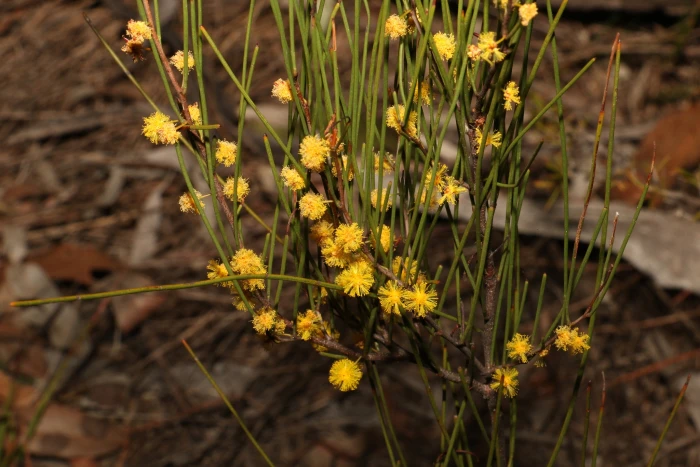Rush-Leaf Wattle
(Acacia juncifolia)
Rush-Leaf Wattle (Acacia juncifolia)
/
/

© Greg Tasney
CC BY-SA 4.0
Image By:
© Greg Tasney
Recorded By:
Copyright:
CC BY-SA 4.0
Copyright Notice:
Photo by: © Greg Tasney | License Type: CC BY-SA 4.0 | License URL: http://creativecommons.org/licenses/by-sa/4.0/ | Uploader: gregtasney | Publisher: iNaturalist |























Estimated Native Range
Climate Requirements for Plum, Pennsylvania
| This Plant | Your Site | Plant Suitability for Your Location | ||
|---|---|---|---|---|
| • Precipitation | 18" - 63" | 40" | Aquatic | Aquatic |
| • High Temp. | 76°F - 96°F | 84°F | Your summer temperatures are normal for this plant. | Excellent |
| • Low Temp. | 35°F - 64°F | 18°F | Your winter temperatures may be too cold for this plant | Too cold |
This plant may not grow well at your location - your precipitation is too high.
Summary
Acacia juncifolia, commonly known as Rush-leaf Wattle, is a shrub or small tree native to the coastal and sub-coastal regions of southeastern Queensland and northeastern New South Wales, Australia. It is typically found in dry sclerophyll forests and woodlands, often on sandy soils, where it contributes to the ecosystem by providing habitat and food for native fauna. Acacia juncifolia can grow up to 10 feet tall and is characterized by its slender, glabrous, reddish-brown branchlets and linear, rigid phyllodes that resemble rushes, hence the common name. The plant produces an abundance of light to deep golden spherical flower-heads from June to November, which are highly attractive to bees and other pollinators.
The Rush-leaf Wattle is valued for its ornamental features, particularly its showy golden blooms that add color to the garden during its long flowering season. It is used in cultivation for habitat restoration, erosion control, and as an ornamental in xeriscaping due to its drought tolerance. This species prefers full sun and is adaptable to a range of well-drained soils, including sandy and poor soils. While it is generally low-maintenance, it may be susceptible to root rot in poorly drained conditions. Acacia juncifolia is not known for aggressive roots or significant disease problems, making it a suitable choice for a variety of garden settings.CC BY-SA 4.0
The Rush-leaf Wattle is valued for its ornamental features, particularly its showy golden blooms that add color to the garden during its long flowering season. It is used in cultivation for habitat restoration, erosion control, and as an ornamental in xeriscaping due to its drought tolerance. This species prefers full sun and is adaptable to a range of well-drained soils, including sandy and poor soils. While it is generally low-maintenance, it may be susceptible to root rot in poorly drained conditions. Acacia juncifolia is not known for aggressive roots or significant disease problems, making it a suitable choice for a variety of garden settings.CC BY-SA 4.0
Plant Description
- Plant Type: Tree, Shrub
- Height: 3-13 feet
- Width: 3-9 feet
- Growth Rate: Moderate
- Flower Color: Yellow
- Flowering Season: Winter, Spring
- Leaf Retention: Evergreen
Growth Requirements
- Sun: Full Sun, Part Shade
- Water: Low
- Drainage: Medium, Fast
Common Uses
Bird Garden, Drought Tolerant, Erosion Control, Low Maintenance, Showy Flowers
Natural Habitat
Native to dry sclerophyll forests and woodlands in coastal and sub-coastal regions of southeastern Queensland and northeastern New South Wales, Australia
Other Names
Common Names: Broom Wattle
Scientific Names: Acacia juncifolia, Acacia juncifolia subsp. juncifolia, Acacia juncifolia var. juncifolia, Acacia pinifolia, Acacia polyantha, Acacia polyantha, Acacia quadrilateralis, Racosperma juncifolium
GBIF Accepted Name: Acacia juncifolia